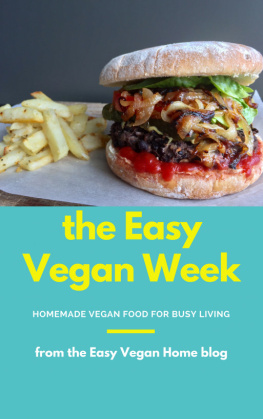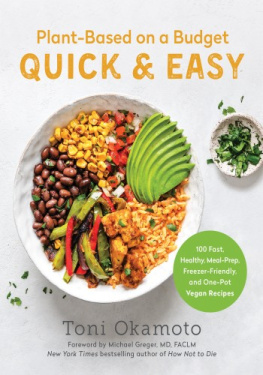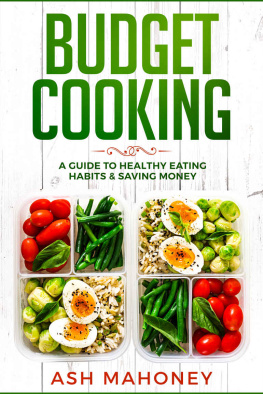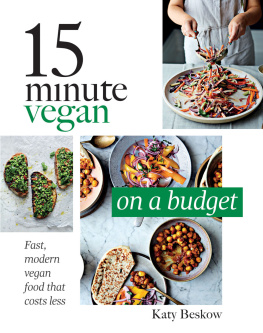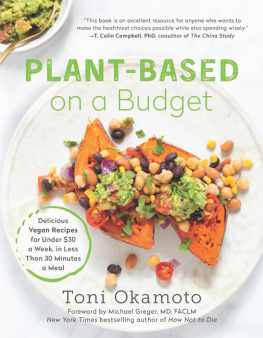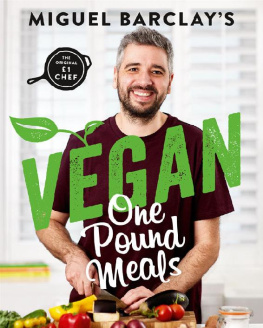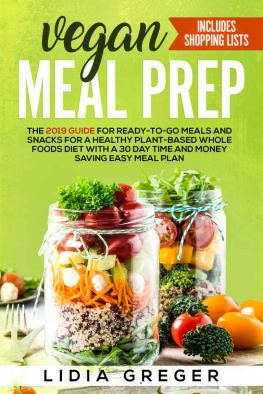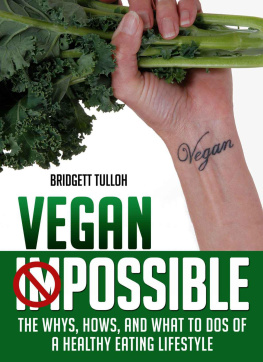Vegan on a Budget
Making Veganism an Affordable Lifestyle
By Lewis Haas
2015
Disclaimer
Although the author and publisher have madeevery effort to ensure that the information in this book wascorrect at press time, the author and publisher do not assume andhereby disclaim any liability to any party for any loss, damage, ordisruption caused by errors or omissions, whether such errors oromissions result from negligence, accident, or any other cause.
This is an informational guide and is notintended as a substitute for medical or professional services.Readers are urged to consult a variety of sources such as theirmedical doctor, dietitian or nutritionist. The informationexpressed herein is the opinion of the author and is not intendedto reflect upon any person or company. The author shall have noresponsibility or liability with respect to any loss or damagecaused, or alleged, by the information or application contained inthis guide. One Jacked Monkey, LLC, and the author are notassociated nor represent any product or vendor mentioned in thisbook.
Introduction: The True Cost of Food
Are youthrifty at the grocery store, or do you take a more liberalviewpoint towards your spending? The answer, according to theUnited States Department of Agriculture (USDA), may surprise you.The USDA uses the following terms to categorize expenditures onfood:
-Thrifty Plan
-Low-Cost Plan
-Moderate Cost Plan
-Liberal Plan
What would a thrifty person spend each weekon food? All food is cooked at home and there is no eating out.Would he spend $50 or $60? In fact, he spends just $38.20 ongroceries. That $50-$60 guess aligns with the moderate plan.Someone who falls under this plan spends $59.80 on food per week.The results are nationwide, so the spending does not factor inhigher costs of living in places like San Francisco, New York, orWashington D.C.
When I read over the spending plans forindividuals and families (a family of 4 spends $149.50 per week ongroceries), my first thought was, But what are they eating? Is itnutritious? Or does it come in a box?
The average American spends just 7% of theirtotal expenses on food. The United States is high-income countryand even its poorest citizens generally fare better than citizensin low-income countries. Yet, the United States spends far lessthan other high-income countries. The average French citizen spendsnearly double that, 13.5% of their income on food. And, Germansspend 11.4% of their income on groceries.
It is a remarkable achievement thatAmericans can spend such a small amount of their income on food.Undernutrition, the type of malnutrition due to deficit caloricintake, is a rare find in the United States. Ironically, there is ahigh cost to these low prices. Michael Pollan, a renowned critic ofthe American food industry calls this externalized costs. Thecost of a $5.00 frozen bulk package of chicken nuggets is much morethan just than the monetary investment. That low-cost stems fromcruel livestock industry practices and paying workers low-wageswith few benefits. That low-cost results in rising obesity ratesand chronic obesity-related illnesses. To make this food so cheapyet still profitable to businesses, quality and ethics aresacrificed for profit.
So, whats the answer? Do I need to shop atexpensive, high-end grocery stores? Or, should I fastidiouslyresearch each product to make sure the food on my table isethically and nutritionally sound? Is there anyway someone with alimited budget can maintain their morality and value system whengrocery shopping?
Here is the solution, plan and simple -veganism. I dont mean a vegan lifestyle that includes fancy,top-of-the-line foods with names you cant pronounce. More so, Imean traditional veganism without marked-up kale chips and chiaseed soy yogurt (both of which you can make on your own with a fewsimple ingredients).
Inexpensive vegan food should not cost verymuch. In other words, the external costs of processed food andanimal products mentioned above do not apply (or at the very least,are minimized as much as possible) when buying whole, plant-basedfood. It is also entirely possible to purchase largely organicproduce on a budget as well, if you spend wisely. This book willdemonstrate how it is possible to adhere to the USDAs low-costspending plan on a whole food, plant-based, vegan diet.Specifically, it will demonstrate and explain how you can spend $52a week and still nourish your body with the best foodsavailable.
Readers at this point must be questioningwhy I chose the second cheapest, rather than the most inexpensivespending plan. First, as noted, the USDAs spending plan isnationwide. It does not account for higher costs of food in Hawaiior expensive metropolitan areas like New York City or SanFrancisco. Therefore, the slightly more liberal spending plan isthrifty in many portions of the United States. I happen to live inone of these more expensive metropolitan communities, and knowfirst-hand the price of food where I live far exceeds the price offood elsewhere. Thirty-eight dollars a week in a place like Bostonor New York City simply isnt realistic.
Food can be inexpensive and should bebudgeted, but you dont want a negative impact on your health justto save money. I do not want you to start thinking of food as aburden, or as something you need to spend as little as possible on.Instead, I want you to think of food in terms of nutritionalefficiency and cost-effectiveness. Food needs to be good for youfirst. Then you should save money when getting the right foods.
The first chapter of this book goes overnutritional requirements and goals to be met, including vitamin,minerals and caloric intake for a moderately active 19-30-year-oldadult. I am using this demographic because the nutritionalrequirements are the commonly cited 2,000 calories per daydiet.
The second chapter of this book focuses ongeneral cost-cutting and cost-saving strategies.
The third and main portion of this book is aseven-day meal plan. The cost of each item is provided. Each dayconcludes with a breakdown of the foods nutrients, gross caloricintake, and the total cost. The chapter ends with a summary of thepercentage (%) of nutritional goals met over the course of sevendays, total caloric intake, and total cost.
The fourth chapter wraps up with areflection on the meal plan and total cost, tips for futurebudgeting, and suggestions to save money on a vegan lifestyle.Finally, the conclusion returns to the idea of the true cost offood and explains why veganism is inexpensive and how thislifestyle has a low-impact on animals and the environment. The bookconcludes by reiterating veganism is a truly thrifty and moral wayto live your life.
Chapter One: Meeting your Nutritional Goalson a Budget
To create ahealthy vegan budget, its first necessary to define what a healthymeal plan is. This chapter will go over nutritional requirementsfor a moderately active female adult according to the United StatesDepartment of Agricultures most recent Dietary Guidelines. Theseguidelines will be used later in this book to measure how well themeals made with a $52 budget fulfill ideal nutritional goals.
Everyone has heard of the term calorie so itis as good a place as any to start. The USDA recommends amoderately active adult woman aged 19-30 consumes anywhere between2,000 to 2,200 calories per day and that a woman aged 30-50consumes between 1,800 to 2,000. Before going any further, I wantto explain a calorie is not an accurate measure of your health oryour foods nutrition. A calorie is just a unit of measurement,like cups or miles are. A calorie measures energy. Specifically, itmeasures the amount of energy it takes to raise either one gram orone kilogram (depending on whether were using gram calories orkilocalories) of water one degree Celsius. Youd be right if younow think it is a bit silly how obsessed with calories weight-lossdiets seem to be. We use calories to measure how much energy weburn. Calories have no insight into the quality of our food. Thisbook uses calories as one of many, many factors that go into ahealthy life style.


